 Email marketing is an extremely powerful tool for business owners. It consistently delivers a high return on investment (ROI), earning businesses an average $38 for every dollar invested.
Email marketing is an extremely powerful tool for business owners. It consistently delivers a high return on investment (ROI), earning businesses an average $38 for every dollar invested.
But email marketing doesn’t mean sending out a regular newsletter. Email marketing covers newsletters, e-receipts, segmentation, automation, and more. And with access to more data than ever, it’s becoming increasingly important for retailers to up their email game. Though email has the potential to drive a lot of sales, three-quarters of that revenue comes from transactional campaigns — NOT newsletters.
Enter the email drip campaign: A way to automate communications, build and nurture connections, and ultimately drive customer loyalty.
What Is an Email Drip Campaign?
An email drip campaign is a series of emails that are automatically sent to a list. These emails typically have a common theme or specific goal in mind, whether it be to drive a purchase, in-store visit, or event registration, for example.
Email drip campaigns are a little more advanced than your standard email newsletter. While a basic email drip campaign may consist of two or three emails sent after a user performs a certain action, others can be more robust, with several possible outcomes based on the user behavior. You may have three buttons to click, for example, and send a different succeeding email for each button.
While email is a common ecommerce marketing tactic, it’s also a great way for physical retailers to reach users on a different medium and create an omnichannel experience. Plus, it provides the building blocks to forge and nurture customer relationships that can lead to lifelong brand loyalty.
Let’s dive into some tips on how to use email drip campaigns to promote your store, and then take a look at some examples to help you plan your campaigns.
Tips for Your Email Drip Campaign
Personalize
Campaign Monitor’s The New Rules of Email Marketing reports that personalized subject lines lead to 26% more opens, and segmentation leads to 760% more revenue. And Statista found that personalized subject lines can increase open rates up to 40.8%. With stats like that, it’s hard to argue against personalizing your email drip campaigns.
Today, personalization in email is a lot more than auto-populating the user’s name in the subject line. The rise of Big Data has given retailers more insight into their audience than ever before, and automation make it easier to leverage that data strategically.
Joel Debus, email marketing specialist at FitSmallBusiness.com, recommends retailers personalize email drip campaigns based on subscriber data and specific actions, or trigger events. See the example below of how FitSmallBusiness.com personalizes their emails.
Using various data points that they have on users, they’re able to auto-fill the users’ preferences and include them in the automated email.
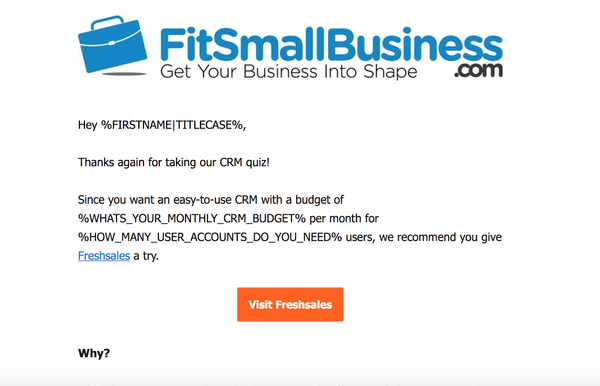 “A retailer could reference past purchases, current interests, location, and even gender to create a personalized email that’s more likely to convert,” Debus says. “Doing so could increase engagement throughout the drip campaign and deliver a more catered experience.”
“A retailer could reference past purchases, current interests, location, and even gender to create a personalized email that’s more likely to convert,” Debus says. “Doing so could increase engagement throughout the drip campaign and deliver a more catered experience.”
Analyze
Once you’ve set up and launched your email drip campaign, you’ll want to keep an eye on its performance. Over time, you’ll be able to see trends that can provide insights into your business, as well as ways to segment the campaign even further.
When analyzing your email drip campaigns, pay special attention to the following:
- Open rate: This is perhaps the most popular stat to check out in regards to email marketing; it simply tells you the rate at which the email is being opened. It’s a good idea to compare these numbers to the actual subject lines to see why they’re successful, and always A/B test your subject line when possible.
- Clicks and click-through rate: While the open rate is important, arguably more important is how many people are actually clicking through your emails or taking the desired call-to-action (CTA). For example, if you’re trying to attract customers to your antique store to check out your new vintage finds, you’ll want to ask customers in-store what brought them in, and train associates to make note of those who comment on your emails.
- Unsubscribes: Consider not only the number of unsubscribes and the unsubscribe rate, but the point at which these unsubscribes are happening. Did you send too many emails? Have they been sent too frequently? Are they relevant to your list?
Optimize
Once you’ve identified what’s working and what’s not through your analysis, it’s time to take those learnings and act on them. Optimizing your campaigns to improve their performance by doing more of the tactics that are working, and reducing the tactics that aren’t.
Over time, you’ll be able to see if the tweaks to your campaigns have hindered or improved performance. Some of these learnings may even be applicable to other areas of your business.
Email Drip Campaigns to Consider
Welcome Email
The welcome email is the first email you send to a user after they’ve joined your list. The welcome email drip is super important, as it’s often the first impression that consumers receive from your brand. Plus, consumers expect an e-greeting from you — nearly three-quarters to be precise, according to a survey conducted by BlueHornet.
But welcome emails also help your bottom line: They generate three times more revenue than other emails, according to Experian. Ecommerce site Dormifyincreased email revenue by 92% after introducing three welcome email series. Even if you don’t sell online, this increased engagement with welcome emails means it’s the perfect time to extend an invitation to your store.
Check out this example of a welcome email from Yoga Pod. It provides a brief greeting, a video with a real person to humanize the brand, links to check out the class schedule, and information about the location of the business.
 SmartrMail also did a thorough analysis of the welcome drip sequence from Barnes & Noble. The email drip campaign includes an initial welcome email, a 15%-off coupon email, an email with recommended products, an email outlining the value of Barnes & Noble, an email promoting their mobile app, and newsletters to follow. The entire sequence gives users a complete look at the brand and continues to highlight the brick-and-mortar locations with a very visible link to their store locator.
SmartrMail also did a thorough analysis of the welcome drip sequence from Barnes & Noble. The email drip campaign includes an initial welcome email, a 15%-off coupon email, an email with recommended products, an email outlining the value of Barnes & Noble, an email promoting their mobile app, and newsletters to follow. The entire sequence gives users a complete look at the brand and continues to highlight the brick-and-mortar locations with a very visible link to their store locator.
Post-Purchase Emails
Post-purchase emails are more than just email receipts. Effective post-purchase email drips may include things like helpful content to make the most of the purchase, related product recommendations, or even solicitations for feedback.
FURTHER READING: Learn more about how to leverage email receipts to boost your retail sales.
Debus says that retailers can use post-purchase email drips to highlight products the user has indicated interest in, as well as complementary products.
Amazon is a prime example of a retailer that uses post-purchase email drips to drive sales, both directly (upsell, cross-promotion, etc.) and indirectly (social proof with customer reviews, customer Q&A, etc.).
Here’s how they make it easy for users to rate and review products:
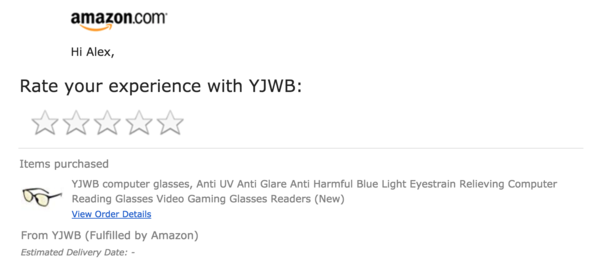 And here’s how they provide personalized product recommendations:
And here’s how they provide personalized product recommendations:
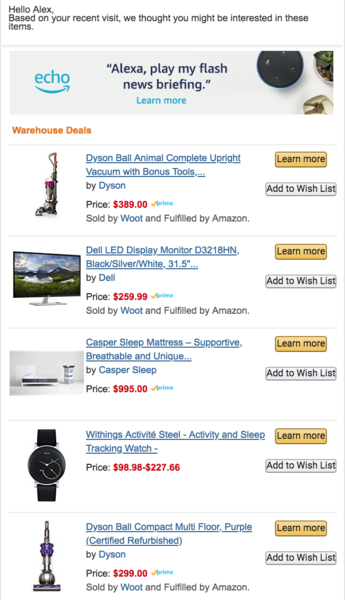 A brick-and-mortar retailer that has effective post-purchase drip campaigns is Sephora. Because they sell products that “expire,” they’ve learned what the average lifetime of the product is and have set up automated emails to remind customers to re-stock after a set amount of time has passed.
A brick-and-mortar retailer that has effective post-purchase drip campaigns is Sephora. Because they sell products that “expire,” they’ve learned what the average lifetime of the product is and have set up automated emails to remind customers to re-stock after a set amount of time has passed.
Debus says these renewal campaigns can be effective for retailers looking to drive sales.
“If a product is disposable and requires a second purchase or more, you can send targeted follow up-emails to re-purchase it whenever that typically runs out (i.e. in 30 days),” he says. “You could even gift 20% off on the second or third purchase.”
To take this idea up a notch, Debus also recommends weaving product recommendations and upselling in the drip campaign.
“You can feature related products that go well with the product [the customer] recently purchased in emails every so often up until the renewal email should be sent,” he says. “This will not only increase the chances of these customers returning to your store, but it will also bolster the perception of your store as helpful and useful in [customers’] lives.”
Even if your product doesn’t have an “expiration” date, you can send reminder emails to customers who haven’t made a purchase in a while. The below example from Grammarly actually pokes fun at the fact that users have been inactive, congratulating them for the feat and offering a discount to re-engage them. A physical retailer could take a similar approach: Perhaps it’s an invitation to shop your store during special hours, or an achievement that earns users with a free gift with their next in-store purchase.
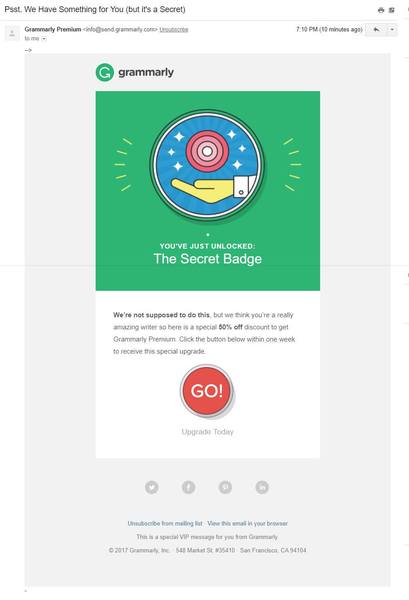 For first-time Dollar Shave Club customers, the email drip campaign goes like this:
For first-time Dollar Shave Club customers, the email drip campaign goes like this:
- Welcome to Dollar Shave Club!: A simple welcome email greeting customers and inviting them to the community.
- Download the FREE DSC App: Promoting the Dollar Shave Club mobile app to give customers a more immersive brand experience.
- Get more popular. Get free stuff.: A referral code, since customers have had a chance to use and love the products.
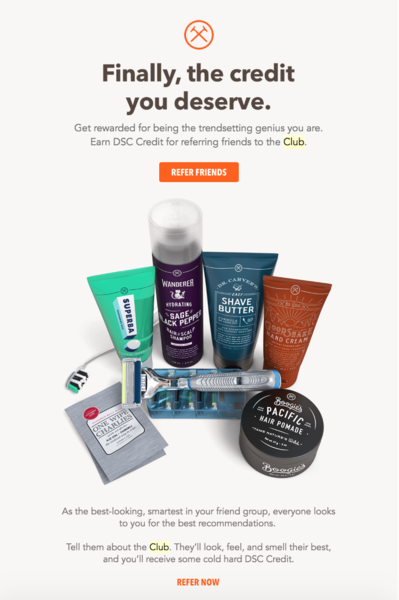
Event Registration and Attendance
If you host in-store events, event registration and attendance give you two new trigger events against which to plan email drip campaigns. This can be helpful in not only making sure event registrants actually attend, but also in nurturing the customer-brand relationship.
Mike’s Camera uses Eventbrite to manage its event registrations. The store uses the platform to send an email drip campaign that reminds users of the event, providing details like the date, time, and location.
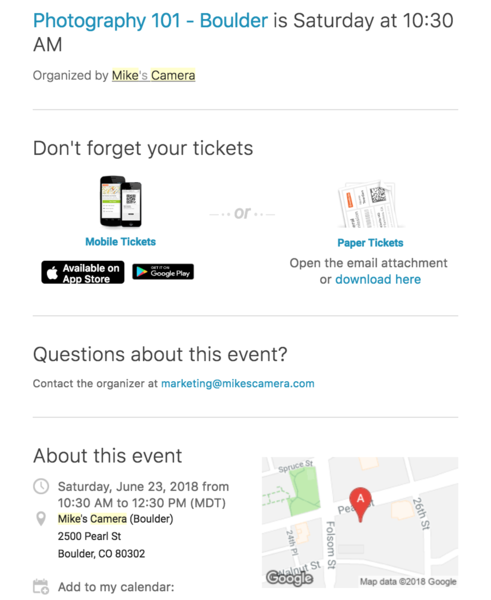 You could take this up a notch by creating your own automated email outside of Eventbrite. You can include your branding, high-quality imagery of your store, and/or product recommendations. In this case, Mike’s Camera could include a link to a blog post about must-have camera accessories for the beginner photographer which would then promote their products. That’s just one way to further improve your event-related email drips.
You could take this up a notch by creating your own automated email outside of Eventbrite. You can include your branding, high-quality imagery of your store, and/or product recommendations. In this case, Mike’s Camera could include a link to a blog post about must-have camera accessories for the beginner photographer which would then promote their products. That’s just one way to further improve your event-related email drips.
Denver’s AIR yoga hosted an event where they provided a complimentary class for members from a local Facebook group. After the class, there were a series of emails where the owner directly asked for feedback about the class. Following that, an email with coupon codes was circulated, encouraging attendees to convert (i.e. purchase a membership).
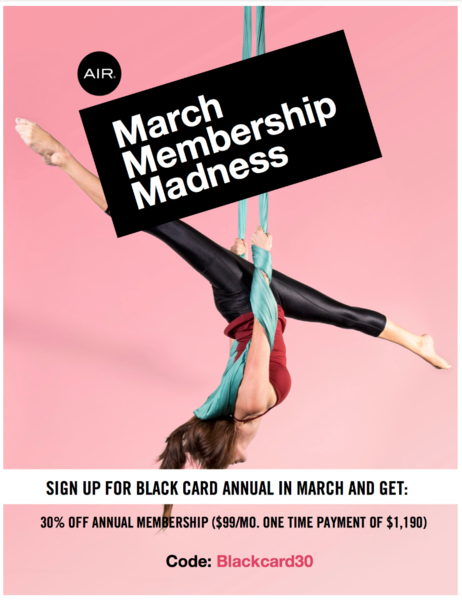 I never did cash in on the promo code, which is likely why I received an additional follow-up email, offering a free class for me and a friend. Which brings us to the last email drip campaign: offers and promos.
I never did cash in on the promo code, which is likely why I received an additional follow-up email, offering a free class for me and a friend. Which brings us to the last email drip campaign: offers and promos.
Offers and Promotions
For our purposes, we’ll talk about offers, promotions, sales, and other in-store campaigns that you’re using email to share with your audience. This could be promo codes, freebies, special access, discounts, or anything else you use to drive a sale.
Overstock offers customers coupons that expire. You’ve Got a 24-Hour Coupon! Use It Before It Disappears! was the subject line of a recent campaign email that I received:
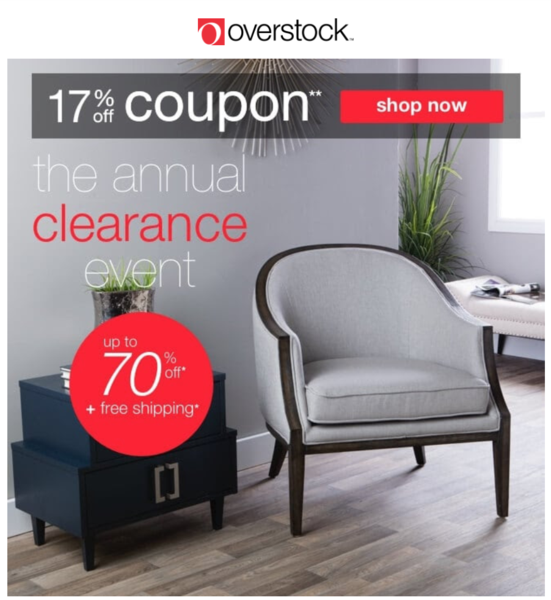 You could make these offers redeemable in-store only so that you’re using email to drive foot traffic to your physical location.
You could make these offers redeemable in-store only so that you’re using email to drive foot traffic to your physical location.
Customer milestones also make for great reasons to offer a discount to your customers. Plus, it’s personal in that it recognizes their birthday, or nurtures your relationship by celebrating their anniversary of being a customer. Here’s how Nike uses email drip campaigns to automate birthday emails:
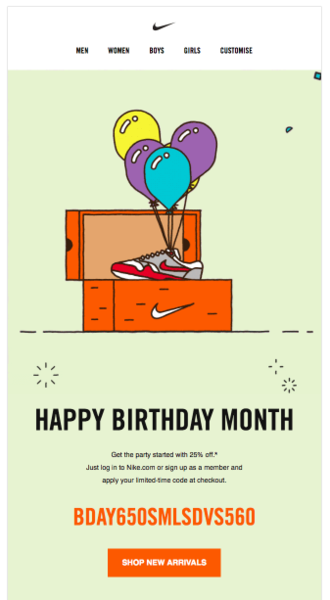 Rather than sending a simple “happy birthday” email, Nike gifts customers with a unique discount code for a 25% discount on a product. Remember to provide value to your customers; don’t wish them happy birthday just for the sake of it.
Rather than sending a simple “happy birthday” email, Nike gifts customers with a unique discount code for a 25% discount on a product. Remember to provide value to your customers; don’t wish them happy birthday just for the sake of it.
Moving Forward With Your Email Drip Campaigns
Email drip campaigns are valuable for retailers because they save time but also allow you to remain present and “on” in the eyes of your customers. Plus, they provide access to plenty of data from which you can gain valuable insights into your business.
When it comes to creating email drip campaigns for your store, remember to keep your store location, hours, and contact information in a visible location — ideally the same spot in each email. So, while your customers are interacting with you online, you’re reiterating that physical presence. Shots of your storefront and interior may be good inclusions as well.
Which retailers do you see using email drip campaigns effectively? What drip sequences do you use for your store?

